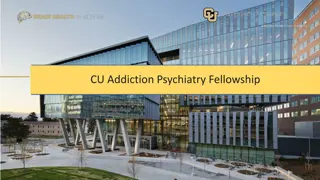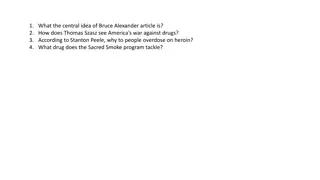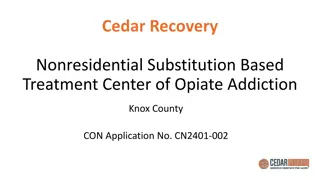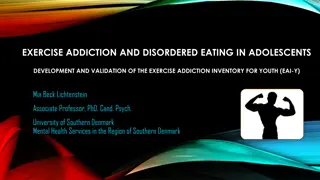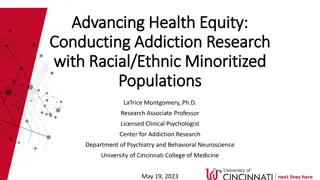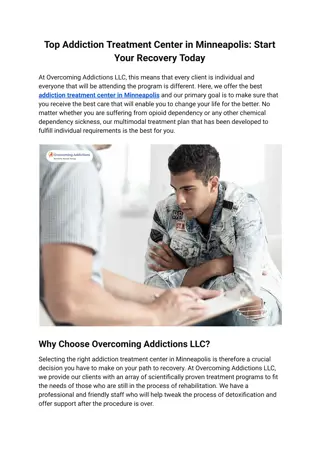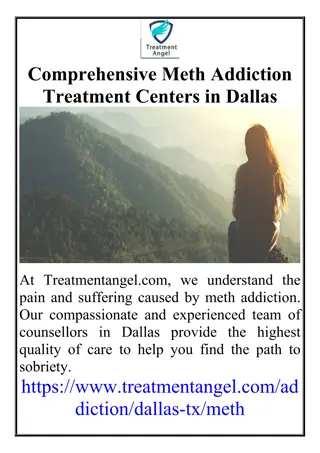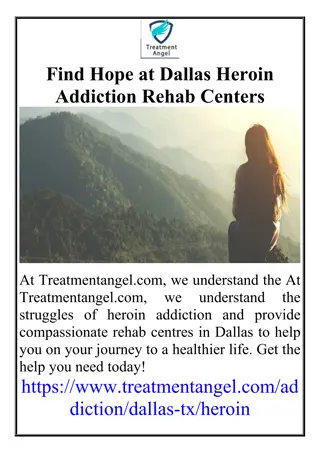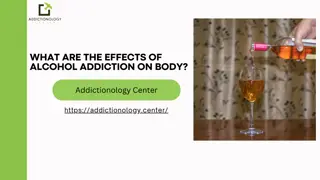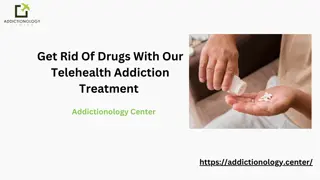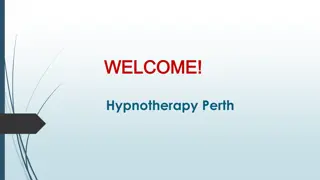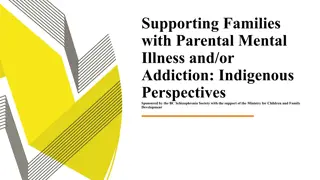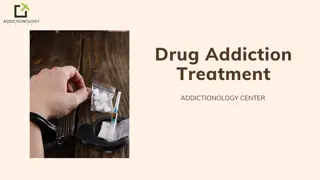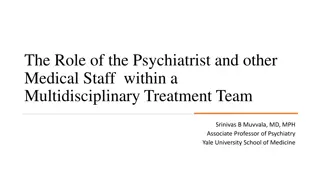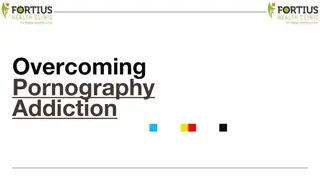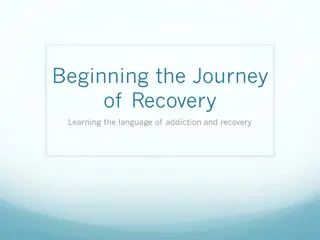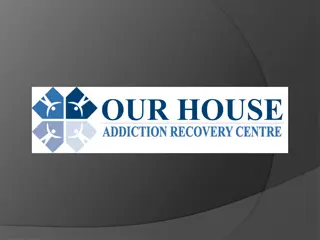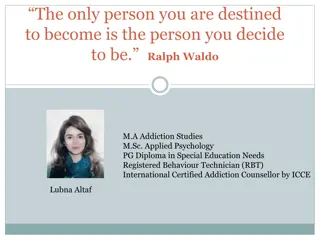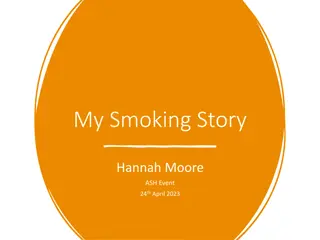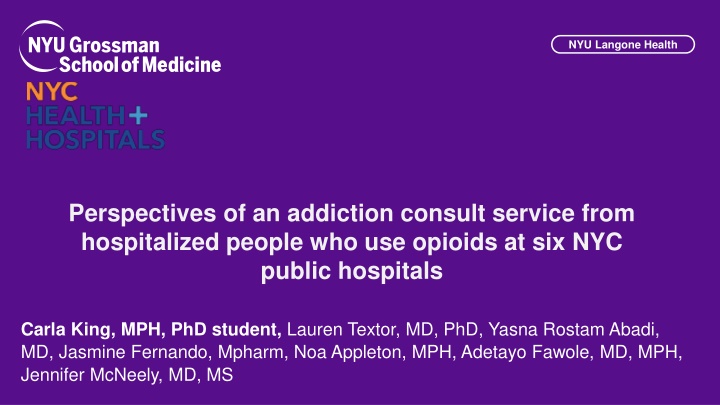
Insights into Addiction Consult Services in NYC Public Hospitals
Explore the perspectives of hospitalized individuals using opioids at NYC public hospitals regarding an addiction consult service. The study aims to understand patient experiences and increase engagement in Medications for Opioid Use Disorder (MOUD). Recruitment methods, participant demographics, and key findings are highlighted.
Download Presentation

Please find below an Image/Link to download the presentation.
The content on the website is provided AS IS for your information and personal use only. It may not be sold, licensed, or shared on other websites without obtaining consent from the author. If you encounter any issues during the download, it is possible that the publisher has removed the file from their server.
You are allowed to download the files provided on this website for personal or commercial use, subject to the condition that they are used lawfully. All files are the property of their respective owners.
The content on the website is provided AS IS for your information and personal use only. It may not be sold, licensed, or shared on other websites without obtaining consent from the author.
E N D
Presentation Transcript
NYU Langone Health Perspectives of an addiction consult service from hospitalized people who use opioids at six NYC public hospitals Carla King, MPH, PhD student, Lauren Textor, MD, PhD, Yasna Rostam Abadi, MD, Jasmine Fernando, Mpharm, Noa Appleton, MPH, Adetayo Fawole, MD, MPH, Jennifer McNeely, MD, MS
No conflicts of interest to disclose Funding sources: NIH/NIDA R01DA045669
ADDICTION CONSULT SERVICES OFFER AN OPPORTUNITY TO ENGAGE PATIENTS IN OUD TREATMENT Increase utilization of medications for opioid use disorder Address lack of knowledge about addiction among health care providers Patients report less judgmental, more humanizing interactions NYC Health + Hospitals implemented a multidisciplinary addiction consult service at 6 hospitals from 2018-2020 Consult for Addiction Treatment and Care in Hospitals (CATCH) (Englander, 2018; Calcaterra, 2022; King 2022; Hyshka, 2019; Collins, 2019; Hoover, 2022)
STUDY AIM Understand the experiences of patients with opioid-related diagnoses hospitalized at a CATCH hospital Conducted as part of a pragmatic trial of the effectiveness of the CATCH program for increasing post-discharge initiation and engagement in MOUD (McNeely, 2019)
RECRUITMENT CATCH teams referred eligible potential participants Had an active opioid use disorder (OUD) or opioid-related poisoning diagnosis 18 years and older English-speaking Patients who accepted or refused the CATCH intervention Target: ~5 patients/hospital with varying demographics (gender, race, ethnicity, age) Semi-structured interviews conducted between October 2019 and April 2021
PARTICIPANT DEMOGRAPHICS (N=29) Black/African American 5 (17%) Women 7 White 7 (24%) Men 22 10 (34%) Other race Missing 7 (24%) Mean age 47 (range: 23-63) Hispanic 20 (61%)
1. Structural vulnerabilities shape addiction trajectories, treatment, and hospital experiences 2. Experiences with CATCH and other health care providers during hospitalization 3. Treatment after hospital discharge
1. Structural vulnerabilities shape addiction trajectories, treatment, and hospital experiences 2. Experiences with CATCH and other health care providers during hospitalization 3. Treatment after hospital discharge
1. Structural vulnerabilities shape addiction trajectories, treatment, and health care experiences Most participants described histories and ongoing forms of structural vulnerabilities and violence Food and financial insecurity Previous incarceration Previous drug overdose Lack of stable housing Exposure to drug use and violence Isolation and abandonment from social networks/supports These experiences structure the risk environment and shape participants experiences of opioid use and health care
Isolation and abandonment But a home is not a home if you re by yourself, it's just a place to live. I can't even cook there. I haven t got my kids, my kids can't come over. I can't have company, that's not a home. That's just a place to stay. Place to wash your ass and take a nap.
1. Structural vulnerabilities shape addiction trajectories, treatment, and hospital experiences 2. Experiences with CATCH and other health care providers during hospitalization 3. Treatment after hospital discharge
2. Experiences with CATCH and other health care providers during hospitalization Overall, participants described positive interactions with the CATCH teams during hospitalization, including adequate and timely access to withdrawal management and more humanizing care Care as conversation and humanization You have somebody to speak to. You feel a little bit more human If you just have a conversation with me, that s what s important CATCH provided support and resources that had not been received prior CATCH as advocate Of course, Dr. B broke his neck for me. He will literally respectfully argue with these doctors CATCH advocates for longer hospital stays, treatment admissions, MOUD refills
2. Experiences with CATCH and other health care providers during hospitalization Inpatient withdrawal management I had about a day or two between my last use and when he gave me the Suboxone. So I was never really sick in here. Like, he came in just the right time. So it really all worked out. Withdrawal management is critical Required before engaging about treatment I mean, it mighta not worked out as well as this if I- if I had the time to, you know, get released from here and then had to wait another week to go to this what am I gonna do in that week if I was active? it could get complicated. So the convenience of everything and it definitely increased the chances of my success. MOUD treatment initiation MOUD in-hospital was convenient and better for retention
2. Experiences with CATCH and other health care providers during hospitalization I meet so many people all day. I ll forget your name the minute you walk out the door. I ve seen a lotta groups- the surgery staff, the internal medicine, CATCH, the social worker, the nurses. It s yeah." So many people all day Patients were visited multiple times daily by health care providers They make you feel bad. Like one minute it could be all, you know, I m tryin to help you, and the minute you say, I m on methadone, they treat you differently. Even with the doctors." Other hospital providers punishing Still experiencing stigma by non-CATCH healthcare providers
1. Structural vulnerabilities shape addiction trajectories, treatment, and hospital experiences 2. Experiences with CATCH and other health care providers during hospitalization 3. Treatment after hospital discharge
3. Treatment after hospital discharge Persistent structural barriers limited participant s desires and abilities to access care after discharge my Medicaid's restricted to a program, so I'm having a problem getting it. I was in [another program] and, for some reason, I'm restricted to them. That means that they want me to stay in their program and not go nowhere else. Sometimes there could be, like, you know, 50 people in line waiting, or sometimes your counselor wants to see you, and you d be stuck there for a half hour, an hour, and then you d be late to work. It s-it s very, very difficult, um, going there every single day.
LIMITATIONS 1) Restricted to English-speaking patients in 6 New York City public hospitals 2) While interviewers were neutral to the intervention, some participants may still consider them part of CATCH 3) Fewer patients who refused CATCH versus those who accepted CATCH 1) -
Addiction consult services can meet an urgent need for humanistic care and medical management of opioid withdrawal for people while they are hospitalized Receive adequate and timely withdrawal management urgently needed! Opportunity for patients to engage with providers about long-term care Patients with OUD have diverse lives and needs, and often imagine ideal care differently For some, capacity to use MOUD long-term was contingent on additional resources Challenging to address during a limited hospital stay
Thank you Special thanks to all the participants, NYC Health + Hospitals CATCH and Office of Behavioral Health team members NYU Langone Health

